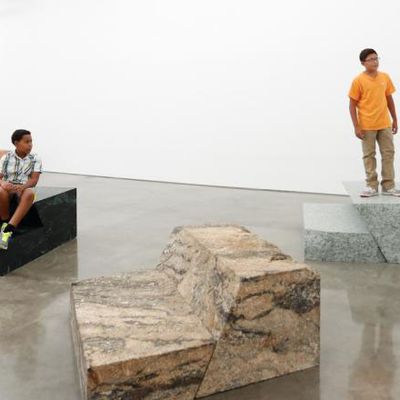
After their atrocious 2011 Venice Biennale U.S. Pavilion ÔÇö it included an upturned tank with a jogger atop, full-size wood reproductions of business-class airline seats with U.S. Olympic gymnasts doing tricks on them (ruining their feet on the terrazzo floor), and some sort of idiotic cash machine in a pipe organ (I think) ÔÇö Jennifer Allora and Guillermo Calzadilla have a lot to answer for.* But the curatorial-darling duoÔÇÖs current Gladstone show only alleviates those past bad judgments a little.
Fault Lines consists of ten large stone ÔÇ£sculptures,ÔÇØ all arranged tastefully about the spacious gallery. In actuality, theyÔÇÖre just unnecessarily heavy steps quarried, polished, moved to, and installed in the gallery at who knows what expense. Once an hour or so, two young male singers step onto the steps, moving about the gallery while singing insults to one another. The music is lovely and original; the performance lasts about 12 minutes. The rest of the time, the gallery is just the stone sculptures. ItÔÇÖs interesting, I guess, that the insults are culled from sources from Cicero and Shakespeare to recent films and politics. And the voices are angelic ÔÇö I loved listening to them. Even though you can only make out a few syllables here and there, some of the jibes are fabulous: ÔÇ£You must be the reason for contraceptionÔÇØ; ÔÇ£Is there no beginning to your talents?ÔÇØ; ÔÇ£If only youÔÇÖd use your brains a little more, you could honestly call yourself a halfwit.ÔÇØ
Yet even though I teared up each time I heard these beautiful singers, I couldnÔÇÖt set aside how incredibly derivative this work is of that of Tino SehgalÔÇÖs. The overlaps are uncanny; itÔÇÖs almost plagiarism. I always tell young artists that if someone uses the bogus criticism ÔÇ£ItÔÇÖs been done before,ÔÇØ that they should ÔÇ£Do it again until you make it all yours.ÔÇØ Unfortunately, A & C only ÔÇ£do it again.ÔÇØ In 2010, in This Progress, Sehgal transformed the emptied-out Guggenheim into an enigmatic Socratic garden where viewers were shepherded up the museum ramp by, among others, young children working from a scripted text. And Sehgal has had young children perform, dance, speak, act, and other things many other times. SehgalÔÇÖs work is almost always experimental, visually austere, electrically aural, immersive, speculatively letting our imaginations soar unencumbered. We leave the realms of art school and art history. Fault Lines, by contrast, is all good-student stagy theater with the range of interpretation seemingly scripted by an academic oversight committee with an eye toward getting into the next textbooks by reinforcing a master narrative of Post-Minimalism and performance art.
The showÔÇÖs press-release ÔÇö presumably fact-checked by the artists ÔÇö claim that the ÔÇ£choral risersÔÇØ took ÔÇ£millions of years to assembleÔÇØ and that ÔÇ£displacing sections of their hardened mass has caused an instant and everlasting rupture in geological time.ÔÇØ Rock took millions of years to form? Who knew? As for ÔÇ£everlasting rupture in geological time,ÔÇØ what fantasyland grandiosity! The sheet goes on to say that these fractures correlate to the inevitable biological ÔÇ£breaking of the voiceÔÇØ that the boys will undergo at puberty. This and the insults supposedly address the ÔÇ£fissures in social and political civility that give rise to turmoil.ÔÇØ #HoplesslySimplisticAndSelfServing
Fault Lines is simply the kind of atria art that goes down easy, making unsuspecting crowds think theyÔÇÖre in the presence of deep thought. A performance with a celebrity sleeping in a box, an artist staring at audience members, and the like. All this work does is momentarily entertain. It is utterly unoriginal, devoid of personal thought, bathed in bathos, subtly sensationalistic, and very windbaggy. Gladstone is one of the best galleries in the world and has been for over two decades. Maybe if this exhibition were at a small Lower East Side or Bushwick gallery, it wouldnÔÇÖt rankle as much as here in one of the epicenters of the art world. In the art world, weÔÇÖre not really allowed to say this kind of thing often ÔÇö and have argued for nearly a century against making such claims ÔÇö but IÔÇÖve been having these sorts of thoughts more and more in the presence of such oversize, big-headed atria art and work that fills our large galleries and international shows: Maybe itÔÇÖs time to say that Fault Lines isnÔÇÖt just bad or very bad art. Maybe we can start to say about such uninventive rehashes of other artistÔÇÖs work that this stuff isnÔÇÖt art at all. ItÔÇÖs just a tasteful idea of other peopleÔÇÖs art. The saddest part is that by now, this may be what new audiences have been trained to see and love.
* This article has been corrected to show that Allora and Calzadilla showed at the 2011 Venice Biennale, not 2012.

